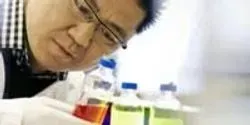News

A team of researchers at the University of Toronto has discovered a method of assembling “building blocks” of gold nanoparticles as the vehicle to deliver cancer medications or cancer-identifying markers directly into cancerous tumors.

When capturing images at the atomic scale, even tiny movements of the sample can result in skewed or distorted images – and those movements are virtually impossible to prevent. Now microscopy researchers at North Carolina State University have developed a new technique that accounts for that movement and eliminates the distortion from the finished product.

New research from the Monell Center reveals humans can use the sense of smell to detect dietary fat in food. As food smell almost always is detected before taste, the findings identify one of the first sensory qualities that signals whether a food contains fat. Innovative methods using odor to make low-fat foods more palatable could someday aid public health efforts to reduce dietary fat intake.

The Clemson University technology that could power industrial tools, run consumer electronics and help reduce carbon emissions starts with building blocks that are about 10,000 times smaller than the diameter of a human hair.















